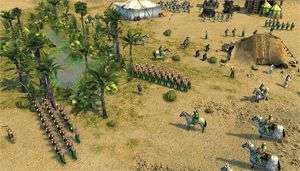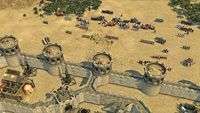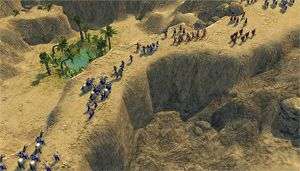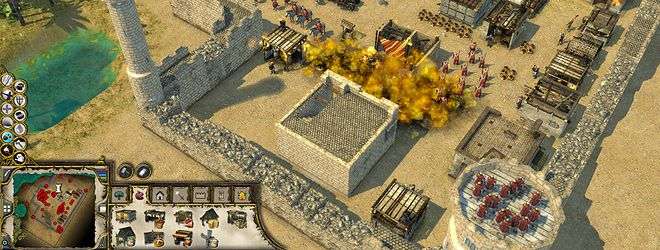Stronghold Crusader 2 – Preview
by Keegan
|
 Do you like castles? I mean, really like castles. Does a good fortification get your blood flowing? Does a correctly spaced murder hole arouse you, even just a little? Don’t worry, you can be honest; we’re all friends here. What’s that? You do? Well then, you’re in the right place, because Stronghold Crusader 2 also likes castles. Well, strongholds, to be precise, but they’re just castles that got out of hand.
Do you like castles? I mean, really like castles. Does a good fortification get your blood flowing? Does a correctly spaced murder hole arouse you, even just a little? Don’t worry, you can be honest; we’re all friends here. What’s that? You do? Well then, you’re in the right place, because Stronghold Crusader 2 also likes castles. Well, strongholds, to be precise, but they’re just castles that got out of hand.
It’s also the kind of game that defies classification into one genre, as it seems to be juggling classic Stronghold elements – castle building at its best – with RTS elements. The original Stronghold Crusader managed to do just that with great aplomb, but that was a decade ago and things have changed a lot over the last ten years. Crusader 2 is trying to return to a genre that is now dominated by StarCraft II rather than Age of Empires, and it’s not even trying to do so with its whole heart. It will never be an eSport game, or played competitively, but the foundations are there for a game that may well be more than enough fun for the rest of us.
Crusader 2 has adapted a new 3D engine which means that, unlike in the first game, it is possible to rotate and zoom, allowing you to check out those murder holes in even closer detail. And the rest of the castle, I guess. Murder holes aside, this new feature allows for greater flexibility in the construction of your castles, as you can use almost any angle while planning your construction.
Allied with that flexibility is the return of a tile-based system for the actual construction of your fortress. Tiles are capable of connecting in eight directions, which results in an inability to create curved walls. However, the lack of curves is a small price to pay for the convenience and simplicity that comes with the new system, especially with the prospect of murderous AI opponents hanging over your head.
 Construction and customisation has been further fleshed out by the addition of more traps and siege units, doubling the number over the previous Crusader game. If you’re someone who enjoys watching boiling pitch being poured over the heads of your assaulters, then this is the game with which to fulfil your sadistic pleasures. You can even set fire to things.
Construction and customisation has been further fleshed out by the addition of more traps and siege units, doubling the number over the previous Crusader game. If you’re someone who enjoys watching boiling pitch being poured over the heads of your assaulters, then this is the game with which to fulfil your sadistic pleasures. You can even set fire to things.
You’ll get to experience those moments in glorious detail thanks to that new 3D engine, which has done wonders for the graphics and general aesthetics. Some of the maps and locations that you’ll battle in are awe-inspiring, with my personal highlight being one which tasks you with building right next to a canyon that dwarfs any stronghold you could ever dream of constructing.
Other graphical tweaks are significantly smaller but, in many ways, are equally impressive, such as arrows bouncing from the walls, individual stones being broken off in chunks when battered with trebuchet missiles and, best of all, your soldiers will drop their swords or daggers and reach for pickaxes when tearing down a wall. Each sounds small in isolation, but when you are watching all three in action during an attack, the overall effect is fantastic, and I can’t help but grin when I see those soldiers pick up pickaxes.
 |
 |
 |
 |
 |
 |
A more realistic physics engine has also been implemented, so when the aforementioned arrows bounce from the walls they do so in a realistic manner. More importantly though, when walls begin to crumble under your barrage of soldiers, siege engines, and trebuchets, they do so in the most satisfying of ways. All walls, no matter how slender, disintegrate in layers, and watching them being pounded into oblivion layer by layer, while bits of rubble and masonry fly about the place, is grimly pleasing. The only way it could be improved upon is if the falling rubble were to take out the men standing behind the wall, but it is early days yet and that may well happen in the final build.
 There’s one more bonus that the 3D engine throws up – the ability to have in-game events. These range from tornadoes to plagues of locusts, each affecting your population in their own way. Tornadoes will tear down houses and kill whomever happens to be caught in it – either that, or it takes them to Oz – while the plague of locusts consumes supplies and lowers your popularity among your subjects which, in turn, makes it harder to recruit soldiers.
There’s one more bonus that the 3D engine throws up – the ability to have in-game events. These range from tornadoes to plagues of locusts, each affecting your population in their own way. Tornadoes will tear down houses and kill whomever happens to be caught in it – either that, or it takes them to Oz – while the plague of locusts consumes supplies and lowers your popularity among your subjects which, in turn, makes it harder to recruit soldiers.
Then there are the AI opponents. It’s important to strike the right balance, as playing as an omnipotent machine that is better than you in every way may be good preparation for when the machines finally rise up, but it’s not particularly fun. I’ve got no idea whether Crusader 2 has it right yet, but they’re certainly making all the right noises.
There are eight potential AI opponents (or allies) and each of them plays differently. These differences can manifest in their building style – some opt for thicker walls, others for tall towers that serve as roosts for archers and those units that fling burning pitch – to their willingness to fight, or the way they choose to do so. One AI, the Shah, was picked out as being against fighting, and was thus a simpler enemy to take down, but equally a poorer ally if you were particularly martial minded.
Thankfully, fighting is not the only way to get things done. You can also opt to be rather more devious, choosing instead to starve out an opponent in an extended siege, or even using the new-and-improved diplomacy systems to get one of their allies to double-cross them and leave them stranded, with no choice but to surrender.
 Conveying the feeling of an actual siege or battle is very much the intention, but the game still has to be fun, so elements such as the diplomacy of battles have been clarified in the hopes that the choices your opponents and allies make are more transparent and understandable. To this end, your opponents will talk to you, just as a human opponent would – trash talk and all – through small voice-acted videos that pop up on your screen. From the looks of it they are seldom pleasant messages, which should only increase the pleasure in crushing them.
Conveying the feeling of an actual siege or battle is very much the intention, but the game still has to be fun, so elements such as the diplomacy of battles have been clarified in the hopes that the choices your opponents and allies make are more transparent and understandable. To this end, your opponents will talk to you, just as a human opponent would – trash talk and all – through small voice-acted videos that pop up on your screen. From the looks of it they are seldom pleasant messages, which should only increase the pleasure in crushing them.
Choosing to destroy them also gives you the opportunity to test all of the new units included in Crusader 2, most of which serve to make the Arab armies play differently to the Western Crusader armies. Apparently the goal of this is to ensure a more guerrilla style of warfare for the Arabs by balancing out fewer units with the myriad of abilities that those units have. The three that were shown appeared to reinforce this theory: the assassin has the ability to climb over walls; the dervish, the historical inaccuracy of whom we shall not go into, has an area of effect attack that quickly slays weak enemies around him; and the slave driver has a buff effect on nearby slaves, making them more effective cannon fodder.
 |
 |
 |
 |
 |
 |
Those abilities do seem to suggest that the Arabs will require a little more thought, especially if you are constantly outnumbered. Another strategic element that will take centre stage is the inability to build without proximity to water, giving the oases added strategic importance, and no doubt making them the centre of any number of pitched battles. At least, I hope they will be.
 There will certainly be some pitched battles in the online skirmish mode, which is where the bulk of the players are expected to spend the majority of their time. It’s where the loyal fanbase for the previous game still lives, and there is a lot of effort going into ensuring that this instalment will be just as welcoming and enjoyable as the last. For the most part, this should ensure that the game performs well online, but there is also one idea that will make for some interesting experimentation – the ability to play a true co-operative mode.
There will certainly be some pitched battles in the online skirmish mode, which is where the bulk of the players are expected to spend the majority of their time. It’s where the loyal fanbase for the previous game still lives, and there is a lot of effort going into ensuring that this instalment will be just as welcoming and enjoyable as the last. For the most part, this should ensure that the game performs well online, but there is also one idea that will make for some interesting experimentation – the ability to play a true co-operative mode.
Rather than each player controlling an army and having them work together, it instead puts both in charge of the same army. Clearly this can lead to some interesting situations (read: arguments), but there are also plenty of opportunities for the mode to allow experienced players to team up with new players who can learn on the job, or two average players to team up and take on some more experienced players on a level playing field. The possibilities are there, and the idea itself is incredibly exciting but, as with the rest of the game, all that remains now is the execution.
Not all signs are good, though, as over the last few years Firefly Studios have garnered a reputation for releasing games that are chock-full of bugs. In fact, Stronghold 3 was marked down in several reviews for being so plagued with bugs as to be almost unplayable. They acknowledge this however, and have insisted that because Crusader 2 is being created without a publisher, they will be able to release their game when it is ready and “super polished”.
I hope that they follow through on that promise because, on current evidence, Stronghold Crusader 2 is geared up to be great. Sure, it’s not going to be the next StarCraft, but hopefully it will be more than enough to keep players coming back for even half as long as the original did. If it does, it may even be the castle builder that keeps me going until I can build one of my own and start an evil empire.
Last five articles by Keegan
- I Heart... Quiplash
- What's a Blood Sport Without Personality?
- XCOM and the Art of Permanence
- Pokken Tournament - Review
- Failure to Launch























I just saw the beta and I was a bit disappointed about the game. There are still some issues from the older versions that still remain (horse on walls)
I thought this one would be more realistic but it is not.